Wilton House Entry Way (picture from internet)
Wilton House was a beautiful Country Home, home of the Earl of Pembroke for centuries. This place was a lot of fun. We were able to walk around the grounds and take pictures.
The county name is Wiltshire which translates to County of Wilt. SHIRE is the name for county in England. From my CJ classes, the constable of the Shire is a Shire Reeve (Sheriff in the USA).
Wilton House Palladial Bridge

I took this picture. The same bridge below is from the internet.
Wilton house - Fountains

Wilton House and Stables - Fountains (Picture from Internet)

I took this picture in 1983. The main thing I remember was how this place was family friendly. They had some great playground equipment that not only the small kids could play on, so could the older kids. There was a rope from one playground equipment to another. Several of the folks with us were trying to go hand over hand to get to the raised platform. They were all failing. I jumped up and was able to make it, however, I had chewing gum in my mouth and was using it to concentrate chewing with big bites. LOL. They told me I would have never made it without my chewing gum. I sucked so badly at gym glasses with rope climbing. Who knew I'd be able to make it on this climb.
Wilton House - side view.
Wilton House is an English country house situated at Wilton near Salisbury in Wiltshire. It has been the country seat of the Earls of Pembroke for over 400 years.
The first recorded building on the site of Wilton House was a priory founded by King Egbert circa 871. Through the munificence of King Alfred, the priory was granted lands and manors until it became wealthy and powerful. However, by the time Wilton Abbey was dissolved in the Dissolution of the Monasteries set in motion by King Henry VIII, its prosperity was already on the wane. Following the seizure of the abbey, Henry presented it and its attached estates to William Herbert, 1st Earl of Pembroke (in the 1551 creation) c. 1544.
Contents
William Herbert, 1st Earl of Pembroke
The east front of Wilton, photographed by Queen Alexandra circa 1907. The central tower is all that remains of the Tudor house.
The granting of an estate such as the Abbey of Wilton to Herbert was an accolade and evidence of his position at court. The first grants dated March and April 1542, include the site of the late monastery, the manor of Washerne adjoining also the manors of Chalke. These were given to "William Herbert, Esquire and Anne his wife for the term of their lives with certain reserved rents to King Henry VIII."[3] When Edward VI re-granted the manors to the family, it was explicitly "to the aforenamed Earl, by the name of Sir William Herbert, knight, and the Lady Anne his wife and the heirs male of their bodies between them lawfully begotten."[4] Lady Anne had been a joint creator of the enterprise.
Herbert immediately began to transform the deserted abbey into a fine house and symbol of his wealth. It had been thought that the old abbey had been completely demolished; however, following renovations after the Second World War traces of the old abbey were found at lower levels of the existing walls.
Hans Holbein
It has long been claimed, without proof, that Hans Holbein the Younger re-designed the abbey as a rectangular house around a central courtyard, which is the core of the present house. Holbein died in 1543, so his designs for the new house would have to have been very speedily executed indeed. However, the great entrance porch to the new mansion, removed from the house and later transformed into a garden pavilion in the 19th century, is to this day known as the "Holbein Porch" — a perfect example of the blending of the older Gothic and the brand-new Renaissance style. If not by Holbein, it is certainly by the hand of a great master.Whoever the architect, nevertheless a great mansion arose. Today only one other part of the Tudor mansion survives: the great tower in the centre of the east facade (see illustration above). With its central arch (once giving access to the court beyond) and three floors of oriel windows above, the tower is slightly reminiscent of the entrance at Hampton Court. Flanked today by two wings in a loose Georgian style – each topped by an Italianate pavilion tower, this Tudor centrepiece of the facade appears not in the least incongruous, merely displaying the accepted appearance of a great English country house, which has evolved over the centuries.
Inigo Jones
Engraving of Wilton House
The architecture of the south front is in severe Palladian style, described at the time as in the "Italian Style;" built of the local stone, softened by climbing shrubs, it is quintessentially English to our eyes today. While the remainder of the house is on three floors of equal value in the English style, the south front has a low rusticated ground floor, almost suggesting a semi-basement. Three small porches project at this level only, one at the centre, and one at each end of the facade, providing small balconies to the windows above. The next floor is the piano nobile, at its centre the great double-height Venetian window, ornamented at second floor level by the Pembroke arms in stone relief. This central window is flanked by four tall sash windows on each side. These windows have low flat pediments. Each end of the facade is defined by "corner stone" decoration giving a suggestion that the single-bay wings project forward. The single windows here are topped by a true pointed pediment.
Above this floor is a further almost mezzanine floor, its small unpedimented windows aligning with the larger below, serve to emphasise the importance of the piano nobile. The roofline is hidden by a balustrade. Each of the terminating 'wings' is crowned by a one storey, pedimented tower resembling a Palladian pavilion. At the time, his style was an innovation. Just thirty years earlier, Montacute House, exemplifying the English Renaissance, had been revolutionary; only a century earlier, the juxtaposing mass of wings that is Compton Wynyates, one of the first houses to be built without complete fortification, had just been completed and was considered modern.
Attributing the various architectural stages can be difficult, and the degree to which Inigo Jones was involved has been questioned. Queen Henrietta Maria, a frequent guest at Wilton, interrogated Jones about his work there. At the time (1635) he was employed by her, completing the Queen's House at Greenwich. It seems at this time Jones was too busy with his royal clients and did no more than provide a few sketches for a mansion, which he then delegated for execution to an assistant Isaac de Caus (sometimes spelt 'Caux'), a Frenchman and landscape gardener from Dieppe.
A document that Howard Colvin found at Worcester College library in Oxford in the 1960s confirmed not only de Caus as the architect, but that the original plan for the south facade was to have been over twice the length of that built; what we see today was intended to be only one of two identical wings linked by a central portico of six Corinthian columns. The whole was to be enhanced by a great parterre whose dimensions were 1,000 feet by 400 feet. This parterre was in fact created and remained in existence for over 100 years. The second wing however failed to materialise – perhaps because of the 4th Earl's quarrel with King Charles I and subsequent fall from favour, or the outbreak of the Civil War; or simply lack of finances.
It is only now that Inigo Jones may have taken a firmer grip on his original ideas. Seeing De Caus' completed wing standing alone as an entirety, it was considered too plain – De Caus' original plan was for the huge facade to have a low pitched roof, with wings finishing with no architectural symbols of termination. The modifications to the completed wing were of a balustrade hiding the weak roof line and Italianate, pavilion-like towers at each end. The focal point became not a portico but the large double height Venetian window. This south front (illustration above), has been deemed an architectural triumph of Palladian architecture in Britain, and it is widely believed that the final modifications to the work of De Caus were by Inigo Jones himself.
Within a few years of the completion of the new south wing in 1647, it was ravaged by fire. The seriousness of the fire and the devastation it caused is now a matter of some dispute. The architectural historian Christopher Hussey has convincingly argued that it was not as severe as some records have suggested. What is definite is that Inigo Jones now working with another architect John Webb (his nephew by marriage to Jones' niece) returned once again to Wilton. Because of the uncertainty of the fire damage to the structure of the house, the only work that can be attributed with any degree of certainty to the new partnership is the redesign of the interior of the seven state-rooms contained on the piano nobile of the south wing; and even here the extent of Jones' presence is questioned. It appears he may have been advising from a distance, using Webb as his medium.
The state rooms
Philip Herbert, 4th Earl of Pembroke, with his family, painted ca. 1634–35 by Anthony van Dyck.
In most English houses today the original intention has been lost, and these rooms have usually become a meaningless succession of drawing rooms; this is certainly true at both Wilton House and Blenheim Palace. The reason for this is that, over time, the traditional occupants of the state bedrooms began to prefer the comfort of a warmer, more private bedroom on a quiet floor with an en-suite bathroom. By the Edwardian Period, large house-parties had adapted the state rooms to use as salons for playing bridge, dancing, talking, and generally amusing themselves.
The magnificent state rooms at Wilton, designed by Inigo Jones and one or another of his partners, are:
- The Single Cube Room: This room is a complete cube 30 ft long (9 m), wide and high, has gilded and white pine panelling, and is carved from dado to cornice. The white marble chimney piece was designed by Inigo Jones himself. The room has a painted ceiling, on canvas, by the Mannerist Italian painter Cavalier D'Arpino, representing Daedalus and Icarus. This room, hung with paintings by Lely and Van Dyck, is the only room thought to have survived the fire of 1647, and thus the only remaining interior of Jones and De Caus.
- The Double Cube Room: The great room of the house. It is 60 ft long (18 m), 30 ft wide (9 m) and 30 ft high (9 m). It was created by Inigo Jones and Webb circa 1653. The pine walls, painted white, are decorated with great swags of foliage and fruit in gold leaf. The gilt and red velvet furniture complements the collection of paintings by Van Dyck of the family of Charles I and the family of his contemporary Earl of Pembroke. Between the windows are mirrors by Chippendale and console tables by William Kent. The coffered ceiling, painted by Thomas de Critz, depicts the story of Perseus. Here again is another anomaly which makes one question the true involvement of Jones: the great Venetian window, centrepiece of the south front and centrepiece of the double cube room, is not the dead centre of the room's outer wall; the other windows in the room are not symmetrically placed; and the central fireplace and Venetian window are not opposite each other as the proportions of a room designed as an architectural feature in itself would demand.
- The Great Anteroom: Before the modifications to the house in 1801, a great staircase of state led from this room to the courtyard below: this was the entrance to the state apartments. Here hangs one of Wilton's greatest treasures: the portrait of his mother by Rembrandt.
- The Colonnade Room: This was formerly the state bedroom. The series of four gilded columns at one end of the room would have given a theatrical touch of importance to the now-missing state bed. It is furnished today with 18th-century furniture by William Kent. The room is hung with paintings by Reynolds and has a ceiling painted in an 18th-century theme of flowers, monkeys, urns, and cobwebs.
- The Corner Room: The ceiling in this room, representing the conversion of Saint Paul, was painted by Luca Giordano. The walls of the room are covered in red damask and adorned with small paintings by, among others, Rubens and Andrea del Sarto.
- The Little Ante Room: The white marble fireplace in this room, with inserts of black marble, is almost certainly by Inigo Jones. The panels in the ceiling were painted by Lorenzo Sabbatini (1530–1577) and therefore are far older than this part of the house; again there are paintings by Van Dyck and Teniers.
- The Hunting Room: This room, not shown to the public, is used as a private drawing room by the Herbert family. It is a square room with white panelling and gilded mouldings. The greatest feature of the room is the set of panels depicting hunting scenes by Edward Pierce painted circa 1653. These panels are set into the panelling rather than framed in the conventional sense.
In 1705, following a fire, the 8th Earl rebuilt some of the oldest parts the house, making rooms to display his newly-acquired Arundel marbles, which form the basis for the sculpture collection at Wilton today. Following this Wilton remained undisturbed for nearly a century.
19th century and James Wyatt
Jones and de Caus's south front and the Palladian bridge (1736-37), in a view of circa 1820
James Wyatt was an architect who often employed the neo-classical style, but at Wilton for reasons known only to architect and client he used the Gothic style. Since the beginning of the 20th century his work at Wilton has been condemned by most architectural commentators. The negative points of his 'improvements' to modern eyes are that he swept away the Holbein porch, reducing it to a mere garden ornament, replacing it with a new entrance and forecourt. This entrance forecourt created was entered through an 'arc de triumph' which had been created as an entrance to Wilton's park by Sir William Chambers circa 1755. The forecourt was bounded by the house on one side, with wings of fake doors and windows extending to form the court, all accessed by Chambers's repositioned arch, crowned by a copy of the life-size equestrian statue of Marcus Aurelius. While not altogether displeasing as an entrance to a country house, the impression created is more of a hunting estate in Northern France or Germany.
James Wyatt's Gothic revival cloisters display the 8th Earl of Pembroke's collection of statuary assembled between 1690 and 1730
There was however one huge improvement created by Wyatt – the cloisters. This two-storeyed gallery which was built around all four sides of the inner courtyard, provided the house with not only the much needed corridors to link the rooms, but also a magnificent gallery to display the Pembroke collection of classical sculpture. Wyatt died before completion, but not before he and Lord Pembroke had quarrelled over the designs and building work. The final touches were executed by Wyatt's nephew Sir Jeffry Wyatville. Today nearly two hundred years later Wyatt's improvements do not jar the senses as much as they did those of the great architectural commentators James Lees-Milne and Sir Sacheverell Sitwell writing in the 1960s. That Wyatt's works are not in the same league of style as the south front, and the Tudor tower, is perhaps something for future generations to judge.
Secondary rooms
Wilton is not the largest house in England by any means: compared to Blenheim Palace, Chatsworth, Hatfield and Burghley House, its size is rather modest. However, aside from the magnificent state rooms, a number of secondary rooms are worthy of mention:- The Front Hall: redesigned by Wyatt, access is gained from this room to the cloisters through two Gothic arches. The room is furnished with statuary; the dominating piece a larger than life statue of William Shakespeare designed by William Kent in 1743. It commemorates an unproved legend that Shakespeare came to Wilton and produced one of his plays in the courtyard.
- The Upper Cloisters: designed by Wyatt but completed circa 1824 by Wyatville in the Gothic style contain neoclassical sculpture, and curios such as a lock of Queen Elizabeth I's hair, and Napoleon I's dispatch box and paintings by the Brueghel brothers.
- The Staircase: Designed by Wyatt, it replaces the muralled state staircase swept away during the 'improvements'. The imperial staircase is lined with family portraits by Lely. Also hanging here is a portrait of Catherine Woronzow, the only sister of 1st Prince Vorontsov and the wife of the 11th Earl; her Russian sleigh is displayed in the cloisters.
- The Smoking Rooms: These rooms are in the wing attributed to Inigo Jones and John Webb linking to the south front. The cornices and doors are attributed to Jones. The larger of the two rooms contains a set of fifty-five gouache paintings of an equestrian theme painted in 1755. The room is furnished with a complete set of bureau, cabinets and break-front bookcases made for the room by Thomas Chippendale.
- The Library: A large book-lined room over 20 yards long, with views to a formal garden and vista leading to the 'Holbein' Porch. This is used as a private room and not shown to the public.
- The Breakfast Room: A private small low-ceilinged room on the rustic floor of the south front. In the 18th century this was the house's only bathroom; more of an indoor swimming pool, the sunken plunge pool was heated and the room decorated in the Pompeian style complete with Corinthian columns. Converted by the Russian Countess of Pembroke to a breakfast room circa 1815, it is today wallpapered in a Chinese design, the paper being an exact copy of that used in the original 1815 decoration of the room. The 18th century furniture of a simulated-bamboo, Gothic style gives this private dining room a distinct oriental atmosphere.
Gardens and grounds
The original gardens included a grotto and water features. Later, when the parterre had been replaced by turf, the Palladian Bridge over the little River Nadder was designed by the 9th Earl, one of the "architect earls," with Roger Morris (1736–37). A copy of it was erected at the much-visited garden of Stowe in Buckinghamshire, and three more were erected, at Prior Park, Bath, Hagley and Amesbury. Empress Catherine the Great commissioned another copy, known as the Marble Bridge, to be set up at the landscape park of Tsarskoye Selo.
In the late 20th century the 17th Earl had a garden created in Wyatt's entrance forecourt, in memory of his father, the 16th Earl. This garden enclosed by pleached trees, with herbaceous plants around a central fountain, has done much to improve and soften the severity of the forecourt.
For younger visitors there is an adventure playground with trampoline, swing boats and climbing ropes.
The park includes an area formerly occupied by much of the village of Fugglestone, which was cleared away, including the site of a medieval leper hospital called the Hospital of St Giles.[5]
Today
The East Front, the entrance front until 1801, contains at its centre all that remains of the original Tudor mansion
- ...the bridge is the object which attracts the visitor before he has become aware of the Jonesian facade. He approaches the bridge and, from its steps, turns to see the facade. He passes through and across the bridge, turns again and becomes aware of the bridge, the river, the lawn and the façade as one picture in deep recession. He may imagine the portico; he will scarcely regret the curtailment. He may picture the formal knots, tortured hedges and statues of the 3rd. Earl's garden; he will be happier with the lawn. Standing here he may reflect upon the way in which a scene so classical, so deliberate, so complete, has been accomplished not by the decisions of one mind at one time but by a combination of accident, selection, genius and the tides of taste.
In film and television
- Scenes from the Stanley Kubrick film Barry Lyndon (1975) were filmed in the Double Cube Room.
- The Double Cube Room was used in The Bounty (1984) to represent the Admiralty building for the court martial of Captain Bligh for the loss of the Bounty.
- The Palladian bridge and gardens were featured in the Blackadder II episode "Bells" and the end titles of all episodes.
- Rooms in Wilton House appear as rooms of Windsor Castle in The Madness of King George (1994) (specifically, the concert with the bell-ringers, and two later scenes with the Prince of Wales, all shot in the Double Cube Room).
- Scenes from Mrs. Brown (1997) were filmed in the Double Cube Room, once again portraying the interior of Windsor Castle.
- Rooms in Wilton House were used for interior scenes at Pemberley (Chatsworth House was used for external shots) in the 2005 film adaptation of the novel Pride and Prejudice.
- Scenes from The Young Victoria, a film about the early years of Queen Victoria's reign, were filmed at Wilton House.
- Scenes from the John Cleese featurette Romance with a Double Bass (1974) were filmed in the Double Cube Room.
Salisbury (various pronunciations,[3] but locally /ˈsɔːzbri/, SAWZ-bree) is a cathedral city in Wiltshire, England, and the only city within the county. It is the third-largest settlement in the county, after Swindon and Chippenham, with a population of 40,302.[4]
The city is located in the southeast of Wiltshire, near the edge of Salisbury Plain. Its cathedral was formerly located to the north at Old Sarum; following its relocation, a settlement grew up around it, drawing residents from Old Sarum and Wilton. The new town received its city charter in 1227 under the name New Sarum, which continued to be its official name until 2009, when the Salisbury City Council was established. It sits at the confluence of five rivers: the Nadder, Ebble, Wylye, and Bourne are tributary to the Hampshire Avon, which flows to the south coast and into the sea at Christchurch in Dorset. Salisbury railway station serves the city and is a regional interchange, at the crossing point between the West of England Main Line and the Wessex Main Line.
Stonehenge, a UNESCO World Heritage Site, is about 8 miles (13 km) northwest of Salisbury and greatly aids the local economy. The city itself, Old Sarum, the present cathedral and the ruins of the former one also attract visitors.
Name
The name Salisbury, which is first recorded around the year 900 as Searoburg (dative Searobyrig), is a partial translation of the Roman Celtic name Sorviodūnum. Brittonic *-dūnon, meaning "fortress" (in reference to the fort that stood at Old Sarum), was replaced by its Old English equivalent -burg. The first part of the name is of obscure origin. The form "Sarum" is a Latinization of Sar, a medieval abbreviation for Middle English Sarisberie.[5]The two names for the city, Salisbury and Sarum, are humorously alluded to in a 1928 limerick from Punch:
Salisbury appeared in the Welsh Chronicle of the Britons as Caer-Caradog, Caer-Gradawc, and Caer-Wallawg.[7][8][9] Cair-Caratauc, one of the 28 British cities listed in the History of the Britons, has also been identified with Salisbury.[10][11]
History
A reconstruction of Old Sarum in the 12th century
Old Sarum
The hilltop at Old Sarum lies near the Neolithic sites of Stonehenge and Avebury and shows some signs of early settlement.[12] It commanded a salient between the River Bourne and the Hampshire Avon near a crossroads of several early trade routes.[13] During the Iron Age, a hillfort (oppidum) was constructed around it sometime between 600 and 300 BC.[13] The Romans may have occupied the site or left it in the hands of an allied tribe. Amid the Saxon invasions, Old Sarum fell to King Cynric of Wessex in 552.[14] Preferring settlements in bottomland like nearby Wilton, the Saxons largely ignored Old Sarum until the Viking invasions led King Alfred to restore its fortifications.[13] Along with Wilton, however, it was abandoned by its residents to be sacked and burned by the Dano-Norwegian king Sweyn Forkbeard in 1003.[15] It subsequently became the site of Wilton's mint.[13] Following the Norman invasion, a motte-and-bailey castle was constructed by 1070.[13] The castle was held directly by the Norman kings; its castellan was generally also the sheriff of Wiltshire.In 1075, the Council of London established Herman as the first bishop of Salisbury,[16] uniting his former sees of Sherborne and Ramsbury into a single diocese which covered the counties of Dorset, Wiltshire, and Berkshire. (He had earlier planned to move his seat to Malmesbury but was blocked by its monks and Earl Godwin.[17]) Hermann and his successor Saint Osmund began the construction of the first Salisbury cathedral but neither lived to see its completion in 1092.[16] Osmund was a cousin of William the Conqueror[18] and Lord Chancellor of England; he was responsible for the codification of the Sarum Rite,[19] the compilation of the Domesday Book (which was probably presented to William at Old Sarum[13]), and—after centuries of advocacy from Salisbury's bishops—was finally canonized by Pope Callixtus III in 1457.[20] The cathedral was consecrated on 5 April 1092 but suffered extensive damage in a storm, traditionally said to have occurred only five days later.[21][22] Bishop Roger was a close ally of Henry I who served as his viceroy during the king's absence to Normandy[23] and directed the royal administration and exchequer along with his extended family.[24] He refurbished and expanded Old Sarum's cathedral in the 1110s and began work on a royal palace during the 1130s, prior to his arrest by Henry's successor Stephen.[23] After this arrest, the castle at Old Sarum was allowed to fall into disrepair, but the sheriff and castellan continued to administer the area under the king's authority.[25]
Salisbury Cathedral as seen from the motte at Old Sarum
New Sarum
Bishop Hubert Walter was instrumental in the negotiations with Saladin during the Third Crusade, but he spent little time in his diocese prior to his elevation to archbishop of Canterbury.[26] The brothers Herbert and Richard Poore succeeded him and began planning the relocation of the cathedral into the valley almost immediately. Their plans were approved by King Richard I but repeatedly delayed: Herbert was first forced into exile in Normandy in the 1190s by the hostility of his archbishop Walter and then again to Scotland in the 1210s owing to royal hostility following the papal interdiction against King John. The secular authorities were particularly incensed, according to tradition, owing to some of the clerics debauching the castellan's female relations.[25] In the end, the clerics were refused permission to reënter the city walls following their rogations and processions.[27] This caused Peter of Blois to describe the church as "a captive within the walls of the citadel like the ark of God in the profane house of Baal". He advocatedLet us descend into the plain! There are rich fields and fertile valleys abounding in the fruits of the earth and watered by the living stream. There is a seat for the Virgin Patroness of our church to which the world cannot produce a parallel.[28]His successor and brother Richard Poore who finally removed the cathedral to a new town on his estate at Veteres Sarisberias ("Old Salisburies") in 1220. The site was at "Myrifield" ("Merryfield"),[29] a meadow near the confluence of the River Nadder and the Hampshire Avon. It was first known as "New Sarum"[28] or New Saresbyri.[27] The town was laid out on a grid.
The Great West Front of Salisbury Cathedral.
New Sarum was made a city by a charter from King Henry III in 1227[30] and, by the 14th century, was the largest settlement in Wiltshire. The city wall surrounds the Close and was built in the 14th century, again with stones removed from the former cathedral at Old Sarum. The wall now has five gates: the High Street Gate, St Ann's Gate, the Queen's Gate, and St Nicholas's Gate were the original ones while a fifth was constructed in the 19th century to allow access to Bishop Wordsworth's School in the Cathedral Close. During his time in the city, the composer Handel stayed in a room above St Ann's gate. The original site of the city at Old Sarum, meanwhile, fell into disuse. It continued as a rotten borough: at the time of its abolishment during the reforms of 1832, its MP represented three households.
A picture of Minster Street, c. 1870
In 1450, a number of riots broke out in Salisbury at roughly the same time Jack Cade led a famous rebellion through London. The riots occurred for related reasons, although the declining fortunes of Salisbury's cloth trade may have also been influential. The violence peaked with the murder of the bishop William Ayscough, who been involved with the government. In 1483, a large-scale rebellion against Richard III broke out, led by his own 'kingmaker', Henry Stafford, 2nd Duke of Buckingham. After the revolt collapsed, Buckingham was executed at Salisbury, near the Bull's Head Inn. In 1664, an act for making the River Avon navigable from Christchurch to the city of New Sarum was passed[32] and the work completed, only for the project to be ruined shortly thereafter by a major flood.[33] Soon after, during the Great Plague of London, Charles II held court in Salisbury's cathedral close.
Salisbury was the site chosen to assemble James II's forces to resist the Glorious Revolution. He arrived to lead his approximately 19 000 men on 19 November 1688. His troops were not keen to fight Mary or her husband William, and the loyalty of many of James's commanders was in doubt. The first blood was shed at the Wincanton Skirmish, in Somerset. In Salisbury, James heard that some of his officers had deserted, such as Edward Hyde, and he broke out in a nosebleed which he took as an omen that he should retreat. His commander in chief, the Earl of Feversham, advised retreat on 23 November, and the next day John Churchill deserted to William. On 26 November, James's own daughter, Princess Anne, did the same, and James returned to London the same day, never again to be at the head of a serious military force in England.[34]
At the time of the 1948 Summer Olympics, held in London, a relay of runners carried the Olympic Flame from Wembley Stadium, where the Games were based, to the sailing centre at Torbay via Slough, Basingstoke, Salisbury, and Exeter.
Salisbury
The 1972 Local Government Act eliminated the administration of the City of New Sarum under its former charters, but its successor—Wiltshire County's Salisbury District—continued to be accorded its former city status. The name was finally formally emended from "New Sarum" to "Salisbury" during the 2009 changes occasioned by the 1992 Local Government Act, which established the Salisbury City Council.Governance
Salisbury now falls under two authorities created in 2009, Salisbury City Council and Wiltshire Council. It was once at the heart of the now defunct Salisbury District, which oversaw most of south Wiltshire as well as the city. When Wiltshire's local government was reorganised under a unitary authority in April 2009, Salisbury City Council was formed, although with fewer responsibilities than the former district council as it is now merely a parish with a great history. There are 8 electoral wards in Salisbury. The city has one Member of Parliament for the Salisbury constituency, currently John Glen (Conservative) who was first elected in the 2010 election.Geography
Queen Elizabeth Gardens showing part of the River Avon diverted through the gardens.
A cause of concern to the people of Salisbury is the lack of adequate roads. Although there is no motorway to link the ports of Southampton and Bristol, traffic passes around the city's ring-road via the A36 to Bath.
There are civil airfields at Old Sarum (where the experimental aircraft the Edgley Optica was developed and tested) and at Thruxton near Andover.
Areas and suburbs
Salisbury has many areas and suburbs, with most of them being former villages that were absorbed by the growth of the city. The boundaries of these areas are for the most part unofficial and not fixed. All of these suburbs are within Salisbury's ONS Urban Subdivision that had a population of 45,354 in 2015.[35]- Bemerton
- Lower Bemerton
- Bemerton Heath
- Hampton Park
- City Centre
- Harnham
- East Harnham
- West Harnham
- Harnham Hill
- Stratford Sub Castle
- Fisherton
- St Mark's (immediately northeast of centre)
- Bishopdown
- Milford
- Petersfinger
- Netherhampton
- Paul's Dene
- Britford
- Odstock
- Quidhampton
- Nunton
- Homington
- Old Sarum
- Little Durnford
- Fugglestone St Peter
- Laverstock and Ford, including Hampton Park, Bishopdown Farm, and Milford Without
- Alderbury
- Bodenham
- Downton
- Wilton
- Charlton All Saints
- Ditchampton
- Bulbridge
- Coombe Bissett
- Ugford
- Chilhampton
- South Newton
Climate
Salisbury experiences an oceanic climate (Köppen climate classification Cfb) similar to almost all of the United Kingdom. The nearest Met Office weather station to Salisbury is Boscombe Down, about 6 miles to the north of the city centre. In terms of the local climate, Salisbury is amongst the sunniest of Inland areas in the UK, averaging over 1650 hours of sunshine in a typical year. Temperature extremes since 1960 have ranged from −12.4 °C (9.7 °F) in January 1963[36] to 34.5 °C (94.1 °F) during July 2006.[37] The lowest temperature to be recorded in recent years was −10.1 °C (13.8 °F) during December 2010.[38]| [hide]Climate data for Boscombe Down 126asl, 1971–2000, Extremes 1960– | |||||||||||||
|---|---|---|---|---|---|---|---|---|---|---|---|---|---|
| Month | Jan | Feb | Mar | Apr | May | Jun | Jul | Aug | Sep | Oct | Nov | Dec | Year |
| Record high °C (°F) | 13.6 (56.5) | 15.7 (60.3) | 21.3 (70.3) | 25.9 (78.6) | 27.5 (81.5) | 33.7 (92.7) | 34.5 (94.1) | 34.2 (93.6) | 27.8 (82) | 26.2 (79.2) | 17.6 (63.7) | 14.3 (57.7) | 34.5 (94.1) |
| Average high °C (°F) | 6.9 (44.4) | 7.3 (45.1) | 9.8 (49.6) | 12.4 (54.3) | 16.1 (61) | 18.9 (66) | 21.7 (71.1) | 21.4 (70.5) | 18.2 (64.8) | 14.1 (57.4) | 10.0 (50) | 7.8 (46) | 13.8 (56.8) |
| Average low °C (°F) | 1.1 (34) | 1.0 (33.8) | 2.8 (37) | 3.8 (38.8) | 6.8 (44.2) | 9.5 (49.1) | 11.8 (53.2) | 11.7 (53.1) | 9.6 (49.3) | 6.9 (44.4) | 3.6 (38.5) | 2.2 (36) | 5.7 (42.3) |
| Record low °C (°F) | −12.4 (9.7) | −9.6 (14.7) | −9.6 (14.7) | −4.7 (23.5) | −2.4 (27.7) | −0.1 (31.8) | 4.4 (39.9) | 3.6 (38.5) | −0.1 (31.8) | −3.4 (25.9) | −6.4 (20.5) | −11.3 (11.7) | −12.4 (9.7) |
| Average precipitation mm (inches) | 76.4 (3.008) | 52.9 (2.083) | 59.0 (2.323) | 48.2 (1.898) | 52.1 (2.051) | 55.1 (2.169) | 40.5 (1.594) | 57.1 (2.248) | 64.5 (2.539) | 70.9 (2.791) | 73.2 (2.882) | 85.9 (3.382) | 735.6 (28.961) |
| Mean monthly sunshine hours | 58.0 | 75.4 | 115.3 | 169.2 | 206.8 | 207.3 | 223.5 | 208.3 | 151.2 | 113.8 | 78.3 | 53.9 | 1,661 |
| Source #1: MetOffice[39] | |||||||||||||
| Source #2: Royal Dutch Meteorological Institute/KNMI[40] | |||||||||||||
Demography
The civil parish of Salisbury – which excludes some of the city's suburbs such as Laverstock, Ford, Britford, Harnham and Odstock – had a population of 40,302 at the 2011 census.[1]The urban zone, which contains the wards immediately surrounding the city, had a population of 62,216 at the 2011 Census.[41] The wards included in this figure are Laverstock, Britford, Downton, Alderbury, Odstock and the neighbouring town of Wilton, among others, however does not include the towns of Amesbury or Romsey as these support their own local populations and are further afield.
At the 2011 census the population of the civil parish was 95.73% white (91.00% White British), 2.48% Asian (0.74% Indian, 0.41% Bangladeshi, 0.40% Chinese), 0.45% black and 1.15% mixed race.[42] There is not much contrast between areas when it comes to ethnic diversity. The ward of St Edmund and Milford is the most multicultural with 86.0% of the population being White British.[43] The least multicultural is the ward of St Francis and Stratford, being 94.8% White British.[44] The city is represented by six other wards.
86.43% of the civil parish's population were born in England, 3.94% were born elsewhere in the UK and 4.94% were born elsewhere in the EU (including the Republic of Ireland), while 4.70% of the population were born outside the EU.[45]
62.49% of the civil parish's population declared their religion as Christianity, while 27.09% stated "no religion" and 8.02% declined to state their religion.[46] 0.79% of the population declared their religion as Islam, 0.41% as Buddhism, 0.40% as Hinduism and 0.80% as some other religion.[46]
95.89% of the civil parish's population considered their "main language" to be English, while 1.12% considered it to be Polish, 0.28% considered it to be Bengali and 0.24% considered it to be Tagalog.[47] 99.43% of the population claimed to be able to speak English well or very well.[48]
In 2001, 22.33% of Salisbury's population were aged between 30–44, 42.76% were over 45, and only 13.3% were between 18–29.[49]
Economy
The 15th-century Poultry Cross originally marked the section of the market trading in poultry.
In 1226, King Henry III granted the Bishop of Salisbury a charter to hold a fair lasting 8 days from the Feast of the Assumption of Mary (15 August).[52] Over the centuries the dates for the fair have moved around, but in its modern guise, a funfair is now held in the Market Place for three days from the third Monday in October. However, there is still an ancient law stating that the fair can be held in the Cathedral Close.
From 1833 to its demolition in the mid-1980s, the Salisbury Gas Light & Coke Company, who ran the city's gasworks, were one of the major employers in the area. The company was formed in 1832 with a share capital of £8,000, and its first chairman was The 3rd Earl of Radnor. The company was incorporated by a private Act of Parliament in 1864, and the Gas Orders Confirmation Act 1882 empowered the company to raise capital of up to £40,000. At its peak, the gasworks were producing not only coal gas but also coke which was sold off as the by-product of gas-making. Ammonical liquor which came out as another by-product in the making of gas, was mixed with sulphuric acid, dried and ground to make a powder which was sold as an agricultural fertiliser. The clinker from the retort house was sold to a firm in London to be used as purifier beds in the construction of sewage works.[53]
Shopping centres include The Old George Mall, The Maltings, Winchester Street and the Crosskeys precinct. Major employers include Salisbury District Hospital. Closure of the Friends Life office, the second largest employer, was announced in 2015.[54]
Culture
Salisbury High Street
St Martin's Church (Church of England)
Salisbury holds an annual St George's Day pageant, the origins of which are claimed to go back to the 13th century.
Salisbury has a strong artistic community, with galleries situated in the city centre, including one in the public library. In the 18th century, John Constable made a number of celebrated landscape paintings featuring the cathedral's spire and the surrounding countryside. Salisbury's annual International Arts Festival, started in 1973, and held in late May to early June, provides a programme of theatre, live music, dance, public sculpture, street performance and art exhibitions. Salisbury also houses a producing theatre – Salisbury Playhouse – which produces between eight and ten plays a year, as well as welcoming touring productions.
Salisbury Museum
Salisbury Museum, housed in the King's House
The permanent Stonehenge exhibition gallery has interactive displays about Stonehenge and the archaeology of south Wiltshire, and its collections include the skeleton of the Amesbury Archer, which is on display.
The Pitt Rivers display holds a collection from General Augustus Pitt Rivers.
The costume gallery showcases costume and textiles from the area with costumes for children to try on while imagining themselves as characters from Salisbury's past.
Also in Salisbury, the former home of Sir Edward Heath is now open as a museum. The house, Arundells, is in the Cathedral Close.
Twinning, Brother, Sister Cities
Salisbury has been twinned with Saintes, France, since 1990;[56] and with Xanten, Germany, since 2005.[56] Salisbury is also a sister city of Salisbury, North Carolina and Salisbury, Maryland, both of which are in the United States.[56]Education
There are numerous schools in and around Salisbury. The city has the only grammar schools in Wiltshire: South Wilts Grammar School for Girls and Bishop Wordsworth's School, which is for boys and is located in the Cathedral Close. Also in the Close is Salisbury Cathedral School. Other schools in or near the city include the Chafyn Grove School, Leehurst Swan School, the Godolphin senior and prep school, St Edmund's Girls' School, Sarum Academy, St Joseph's Catholic School and South Wiltshire UTC.Sixth form education is offered by Salisbury Sixth Form College, while the Salisbury campus of Wiltshire College offers a range of further education courses, as well as some higher education courses in association with Bournemouth University. Sarum College is a Christian theological college located within the Cathedral close in Salisbury.
Transport
Road
The main transport links for the city are the roads. Salisbury lies on the intersection of the A30, the A36 and the A338 and is at the end of the A343, A345, A354 and A360. Car parks around the periphery of the city are linked to the city centre by a park and ride scheme (see details in the bus section below). The A36 forms an almost complete ring road around the city centre.Bus
There are bus links to Southampton, Bournemouth and Andover working seven days a week with limited services on Sundays. Wilts & Dorset are the main local bus company, part of the Go-Ahead group. Stagecoach in Hampshire runs the number 87 to Andover every two hours from Salisbury and also every other journey on route 8 to Andover via Amesbury and Tidworth along with Wilts & Dorset. Bodman's also runs the number 24 bus between Salisbury and Warminster,[57] which replaced the X4/X5 service which used to run between Salisbury and Bath.Salisbury also has a Park and Ride bus scheme with five sites around the city. These park and ride sites attempt to relieve pressure on the city centre, but as of 2010, run at an annual loss of £1 million.[58] The Park and Ride sites, which are funded by Wiltshire Council and cost £2.50 for parking and bus transport for an individual or £3.50 for up to six passengers, are:[59] 501 Beehive – |A345 Castle Road to the north, 502 Wilton – A36 Wilton Road to the west, 503 Britford – A338 Downton Road to the south, 504 London Road – A30 London Road to the northeast, 505 Petersfinger – A36 Southampton Road, to the southeast.[58]
Railways
Salisbury railway station is the crossing point of the West of England Main Line, from London Waterloo to Exeter St Davids, and the Wessex Main Line from Bristol Temple Meads to Southampton Central. The station is operated by South Western Railway. Great Western Railway hourly trains call from Cardiff Central, Bristol Temple Meads, Bath Spa to Southampton Central and Portsmouth Harbour.
Salisbury Racecourse with the cathedral in the distance
Sport and leisure
The city has a football team, Salisbury F.C., who play in the Southern League Division One South & West and are based at the Raymond McEnhill Stadium on the northern edge of the city. Non-league clubs are Bemerton Heath Harlequins F.C. and Laverstock & Ford F.C..Salisbury Rugby Club, which is based at Castle Road, play in National League 3 South West.
South Wilts Cricket Club is based at the Salisbury and South Wiltshire Sports Club and play in the Southern Premier Cricket League, which they have won five times in the past 25 years. They produce many juniors which represent both Hampshire and Wiltshire at county level.
Winterbourne Cricket Club is based in Winterbourne Gunner and Farley Cricket Club is based at Coronation Field, Farley.[60][61] Salisbury Hockey Club is also based at the Salisbury and South Wilts Sports Club.[62]
The Five Rivers Leisure Centre and Swimming Pool is located just outside the ring road and was opened in 2002. Salisbury Racecourse is a flat racing course to the south-west of the city. Five Rivers Indoor Bowls Club and Salisbury Snooker Club share a building on Tollgate Road (behind the College). The snooker club also has sections for pool and darts. The Bishop's Walk on the edge of the city provides a popular viewing point.
Old Sarum Airfield, north of the city centre, is home to a variety of aviation-based businesses including flying schools and the APT Charitable Trust for disabled flyers.
The city's theatre is the Salisbury Playhouse. The City Hall is an entertainment venue and hosts comedy, musical performances (including those by the resident Musical Theatre Salisbury) as well as seminars and conventions. Salisbury Arts Centre, housed in a redundant church, has exhibitions and workshops.
Salisbury is well-supplied with pubs. The Haunch of Venison, overlooking the Poultry Cross, operates from a 14th-century building; one of its attractions is a cast of a mummified hand, supposedly severed during a game of cards.[63] The Rai d’Or has original deeds dating from 1292. It was the home of Agnes Bottenham, who used the profits of the tavern to found Trinity Hospital next door around 1380.
Some buildings in Salisbury are reputed to be haunted. Ghost tours are popular with locals and visitors. One such building is the local Odeon cinema located in the Hall of John Halle – the oldest building in the UK to contain a cinema. The Debenhams department store is said to be haunted by Henry Stafford, 2nd Duke of Bu
Salisbury Cathedral
Salisbury Cathedral - Magna Carta
Salisbury Cathedral’s Magna Carta is the best preserved of only four surviving original exemplars, the other three 1215 Magna Cartas are held at The British Library and Lincoln Castle. It is displayed in our magnificent 13th century Chapter House at the heart of a permanent, Looking at this picture (from the internet), I remember standing in line waiting to get inside to see the copy of the Magna Carta and the exhibits there. The exhibit includes pictures of King George VI and family including the future Queen Elizabeth II.
Salisbury Cathedral Ceiling
Interior of Spire

Salisbury (Roof interior - carved stone) - internet photo
Cloister Garden
Wikipedia
Salisbury Cathedral, formally known as the Cathedral Church of the Blessed Virgin Mary, is an Anglican cathedral in Salisbury, England, and one of the leading examples of Early English architecture.[2] The main body of the cathedral was completed in only 38 years, from 1220 to 1258.
Since 1549, the cathedral has had the tallest church spire in the United Kingdom, at 404 feet (123m). Visitors can take the "Tower Tour" where the interior of the hollow spire, with its ancient wood scaffolding, can be viewed. The cathedral also has the largest cloister and the largest cathedral close in Britain (80 acres (32 ha)).[2] It contains the world's oldest working clock (from AD 1386) and has the best surviving of the four original copies of Magna Carta.[2] In 2008, the cathedral celebrated the 750th anniversary of its consecration.[3]
The cathedral is the mother church of the Diocese of Salisbury and is the seat of the Bishop of Salisbury, currently the Right Reverend Nick Holtam.
History
Sculpture on the west front of the cathedral of Bishop Richard Poore who oversaw the early years of its construction, beginning in 1220. He is holding a model of the cathedral
The foundation stone was laid on 28 April 1220.[7] Much of the freestone for the cathedral came from Teffont Evias quarries.[8] As a result of the high water table in the new location, the cathedral was built on only four feet of foundations, and by 1258 the nave, transepts and choir were complete. The only major sections built later were the cloisters in 1240, the chapter house in 1263, the tower and spire, which at 404 feet (123 m) dominated the Wiltshire skyline from 1320. Because most of the cathedral was built in only 38 years, it has a single consistent architectural style, Early English Gothic.
Although the spire is the cathedral's most impressive feature, it has proved to be troublesome. Together with the tower, it added 6,397 tons (6,500 tonnes) to the weight of the building. Without the addition of buttresses, bracing arches and anchor irons over the succeeding centuries, it would have suffered the fate of spires on other great ecclesiastical buildings (such as Malmesbury Abbey 1180 to ~1500, Lincoln Cathedral 1311 to 1549 and Chichester Cathedral 1402 to 1861) and fallen down; instead, Salisbury became the tallest church spire in the UK on Lincoln's collapse. The large supporting pillars at the corners of the spire are seen to bend inwards under the stress. The addition of reinforcing tie beams above the crossing, designed by Christopher Wren in 1668, arrested further deformation.[9] The beams were hidden by a false ceiling, installed below the lantern stage of the tower.
Significant changes to the cathedral were made by the architect James Wyatt in 1790, including replacement of the original rood screen and demolition of a bell tower which stood about 320 feet (100 m) northwest of the main building. Salisbury is one of only three English cathedrals to lack a ring of bells, the others being Norwich Cathedral and Ely Cathedral. However it does strike the time every 15 minutes with bells. In total, 70,000 tons of stone, 3,000 tons of timber and 450 tons of lead were used in the construction of the cathedral.[10]
Building and architecture
West front
The west front is of the screen-type, clearly deriving from that at Wells. It is composed of a stair turret at each extremity, with two niched buttresses nearer the centre line supporting the large central triple window. The stair turrets are topped with spirelets, and the central section is topped by a gable which contains four lancet windows topped by two round quatrefoil windows surmounted by a mandorla containing Christ in Majesty. At ground level there is a principal door flanked by two smaller doors. The whole is highly decorated with quatrefoil motifs, columns, trefoil motifs and bands of diapering.The west front was almost certainly constructed at the same time as the cathedral.[11] This is apparent from the way in which the windows coincide with the interior spaces. The entire façade is about 33 metres high and wide. It has been said that the front was built on a scale smaller than was initially planned. It lacks full-scale towers and/or spires as can be seen, for example at Wells, Lincoln, Lichfield, etc.[12] The facade is disparaged by Alec Clifton-Taylor,[13] who comments that it is the least successful of the English screen-facades and is a travesty of its prototype (Wells). He finds the composition to be unco-ordinated, and the Victorian statuary "poor and insipid".
The front accommodates over 130 shallow niches of varying sizes, 73 of these niches contains a statue. The line of niches extend round the turrets to the north, south and east faces. There are five levels of niches (not including the mandorla) which show, from the top, angels and archangels, Old Testament patriarchs, apostles and evangelists, martyrs, doctors and philosophers and, on the lower level, royalty, priests and worthy people connected with the cathedral. The majority of the statues were placed during the middle of the 19th century, however seven are from the 14th century and several have been installed within the last decade.
The nave
Chapter house and Magna Carta
The chapter house is notable for its octagonal shape, slender central pillar and decorative medieval frieze. It was redecorated in 1855-9 by William Burges. The frieze circles the interior above the stalls and depicts scenes and stories from the books of Genesis and Exodus, including Adam and Eve, Noah, the Tower of Babel, and Abraham, Isaac and Jacob.The chapter house also displays the best-preserved of the four surviving original copies of Magna Carta. This copy came to Salisbury because Elias of Dereham, who was present at Runnymede in 1215, was given the task of distributing some of the original copies. Elias later became a canon of Salisbury and supervised the construction of the cathedral.
Depictions in art, literature and film
Salisbury Cathedral by John Constable, ca. 1825.
Paintings and other artistical objects
The cathedral is the subject of famous paintings by John Constable. As a gesture of appreciation for John Fisher, the Bishop of Salisbury, who commissioned this painting, Constable included the bishop and his wife in the canvas (bottom left). The view depicted in the paintings has changed very little in almost two centuries.The cathedral is also the subject of William Golding's novel The Spire which deals with the fictional Dean Jocelin who makes the building of the spire his life's work. The construction of the cathedral is an important plot point in Edward Rutherfurd's historical novel Sarum, which explores the historical settlement of the Salisbury area. The cathedral has been mentioned[16] by the author Ken Follett as one of two models for the fictional Kingsbridge Cathedral in his historical novel The Pillars of the Earth. It was also used for some external shots in the 2010 miniseries based on Follett's book and was shown as it is today in the final scene. The cathedral was the setting for the 2005 BBC television drama Mr. Harvey Lights a Candle, written by Rhidian Brook and directed by Susanna White. Kevin McCloud climbed the cathedral in his programme called Don't Look Down! in which he climbed high structures to conquer his fear of heights. The cathedral was the subject of a Channel 4 Time Team programme which was first broadcast on 8 February 2009.
The medieval clock
Clock
The Salisbury cathedral clock dating from about AD 1386 is supposedly the oldest working modern clock in the world.[17] The clock has no face because all clocks of that date rang out the hours on a bell. It was originally located in a bell tower that was demolished in 1792. Following this demolition, the clock was moved to the Cathedral Tower where it was in operation until 1884. The clock was then placed in storage and forgotten until it was discovered in 1929, in an attic of the cathedral. It was repaired and restored to working order in 1956. In 2007 remedial work and repairs were carried out to the clock.[18]Dean and chapter
- Dean – The Very Revd June Osborne (since 1 May 2004 installation)[19]
- Precentor – The Revd Canon Tom Clammer (since 29 April 2012 installation)[20]
- Chancellor – The Revd Canon Ed Probert (since 4 April 2004 installation)[21]
- Treasurer – The Revd Canon Robert Titley (since November 2015 installation)[22]
Burials
The North transept
- William Longespée, 3rd Earl of Salisbury, (c1165 to 1226)
- Lady Catherine Grey, Countess of Hertford (1540 to 1568)
- Saint Osmund, Bishop of Salisbury (1078 to 1099)
- Roger of Salisbury, Bishop of Salisbury (1102 to 1139)
- Josceline de Bohon, Bishop of Salisbury (1142 to 1184)
- Robert de Bingham, Bishop of Salisbury (1229 to 1246)
- Giles of Bridport, Bishop of Salisbury (1256 to 1262)
- Walter de la Wyle, Bishop of Salisbury (1263 to 1271)
- Nicholas Longespee, Bishop of Salisbury (1291 to 1297)
- Simon of Ghent, Bishop of Salisbury (1297 to 1315)
- Roger Martival, Bishop of Salisbury (1315 to 1330)
- Walter Hungerford, 1st Baron Hungerford (1378–1449)
- Richard Mitford, Bishop of Salisbury (1395 to 1407)
- Robert Hungerford, Lord Moleyns and 3rd Baron Hungerford (1431–1464)
- Richard Beauchamp, Bishop of Salisbury (1450 to 1482)
- Edmund Audley, Bishop of Salisbury (1501 to 1524)
- John Jewel, Bishop of Salisbury (1559 to 1571)
- Edmund Gheast, Bishop of Salisbury (1571 to 1577)
- Alexander Hyde, Bishop of Salisbury (1665 to 1667)
- John Thomas, Bishop of Salisbury (1761 to 1766)
Music
The Choir
The Trinity Chapel (Lady Chapel). The artwork below the stained glass window is the temporary exhibition of Nicholas Pope
installation called "The Apostles Speaking in Tongues Lit By Their Own
Lamps", shown at Salisbury Cathedral from 8 June until 4 August 2014
Organ
The cathedral's current organ was built in 1877 by Henry Willis & Sons.[24] Sir Walter Alcock, who was organist of the cathedral from 1916, oversaw a strictly faithful restoration of the famous Father Willis organ, completed in 1934,[25] even going to such lengths as to refuse to allow parts of the instrument to leave the cathedral in case any unauthorised tonal alterations were made without his knowledge,[26] while allowing some discreet additions in the original style of the organ (as well as modernisation of the organ's actions) by Henry Willis III, the grandson of Father Willis.[27]An earlier organ by Samuel Green was presented by King George III in 1792[28] and was installed on top of the stone screen, which, unusually, did not divide the choir from the nave, but rather came from an unknown location in the cathedral.[29] The organ was later taken out and moved to St Thomas's Church.[30]
Organists
It is recorded that in 1463 John Kegewyn was organist of Salisbury Cathedral. Among the notable organists of more recent times have been a number of composers and well-known performers including Bertram Luard-Selby, Charles Frederick South, Sir Walter Alcock, David Valentine Willcocks, Douglas Albert Guest, Christopher Dearnley, Richard Godfrey Seal and the BBC presenter Simon Lole.Choir
Salisbury Cathedral Choir auditions boys and girls aged 7–9 years old annually for scholarships to Salisbury Cathedral School, housed in the old Bishop's Palace. The boys choir and the girls choir (each 16 strong) sing alternate daily Evensong and Sunday Matins and Eucharist services throughout the school year. There are also many additional services during the Christian year particularly during Advent, Christmas, Holy Week, and Easter. The Advent 'From Darkness to Light services are the best known. Choristers come from across the country, some boarding. Six lay vicars (adult men) comprise the rest of the choir (singing tenor, alto and bass parts).Cathedral constables
The cathedral previously employed five cathedral constables (known as "Close Constables"). Their duties mainly concerned the maintenance of law and order in the cathedral close. They were made redundant in 2010 as part of cost-cutting measures and replaced with "traffic managers".[31]The constables were first appointed when the cathedral became a liberty in 1611 and survived until the introduction of municipal police forces in 1835 with the Municipal Corporations Act.[32] In 1800 they were given the power, along with the city constables, to execute any justices' or court order requiring the conveyance of prisoners to or from the county gaol (at Fisherton Anger, then outside the city of Salisbury) as if it were the city gaol (and, in so doing, they were made immune from any legal action for acting outside their respective jurisdictions).[33] The right of the cathedral, as a liberty, to maintain a separate police force was conclusively terminated by the Local Government Act 1888.[34][35]
In February 2016 the statue The Kiss by Sophie Ryder, which was planned to be in place until July, had to be moved because people kept walking into it while texting.[36]
Gallery
The interior of the spire, showing the original supporting framework.









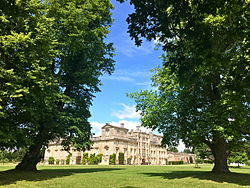
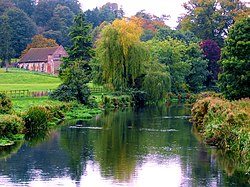
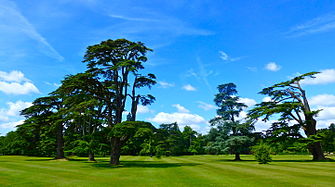


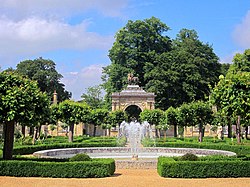









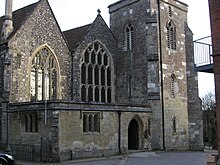
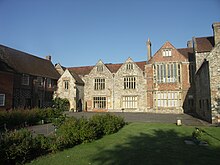
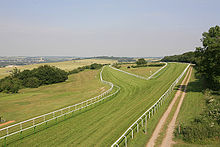








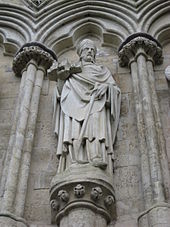


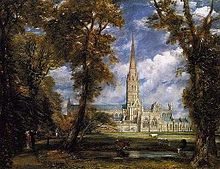
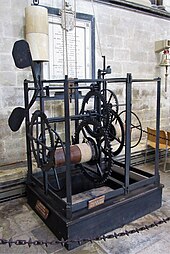


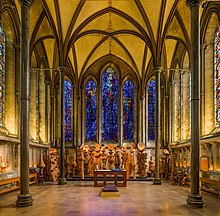

No comments:
Post a Comment